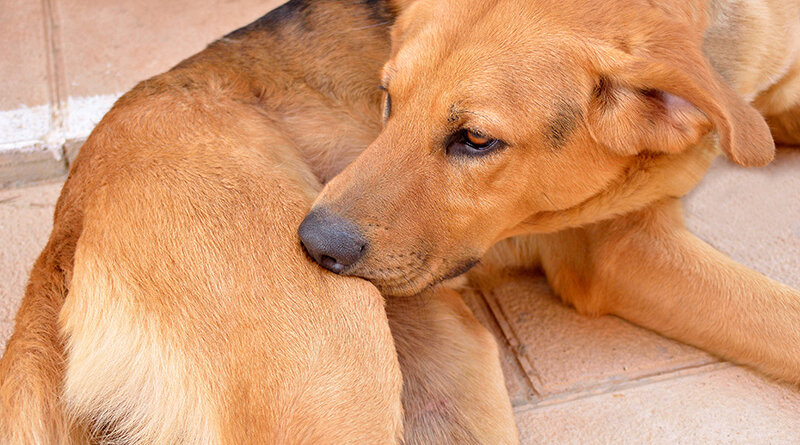How to Get Rid of Fleas on Dogs, Naturally!
Fleas are a nuisance, both to your dog and to your household. To combat them, you have a choice between commercial chemical products and natural remedies. In this article, you’ll learn the benefits of natural home remedies, many of which you can make from ingredients you probably already have in your pantry.
Regardless of where they live, what their daily lives are like or what breed they are, many dogs are afflicted by fleas. These small pests, whose bite provokes an itching sensation, irritate dogs no end, resulting in what seems like endless scratching.
Scratching is just the tip of the proverbial iceberg, however. Dogs who are allergic to flea saliva can develop skin redness, welts and swelling, not to mention skin lesions from constant licking. Flea bites can also cause anemia, and—if fleas are ingested during the dog’s non-stop grooming—tapeworm infestations.
Then there’s the housework. A dog’s constant scratching spreads loose hair and dead skin. Adding to the challenge, fleas lay eggs in inaccessible and difficult-to-clean areas of your home, including along baseboards, under furniture and in cracks in floorboards.
Clearly, you need to fight back, both for your dog’s sanity and your own. Here are some home remedies to get rid of fleas.
GET THE BARK IN YOUR INBOX!
Sign up for our newsletter and stay in the know.
On Your Dog …
Depending on where you live, fleas may be a seasonal or a year-round problem. Generally, they’re the biggest menace during the summer, when dogs spend more time outside. Fleas themselves are very tiny and move quickly, so a simple visual inspection isn’t always enough. To find out if your dog has fleas, check for black specks on his coat and skin. These are flea droppings (gross!). Or, check for specks by rubbing a white tissue across your dog’s fur. Following are some natural next-steps if your sleuthing turns up evidence.
Flea comb
An affordable and practical solution, a flea comb is a must-have for dog owners looking for a natural flea-killer. They come in various sizes, but all have closely spaced teeth that remove both eggs and fleas from the dog’s coat. (Be sure to dip the comb in soapy water after each pass to kill the eggs and adults the comb picks up.) This is a great first step in your war on these pests.
Lime or lemon comb/lemon bath
Dip your dog’s comb in fresh lime or lemon juice and make multiple passes through his coat. (If your dog has a short or slick coat, you can also use a cloth dipped in the juice instead of a comb.) Another option is to dilute lemon juice with water (1:2 ratio) and add a splash of pet shampoo.
Apple Cider Vinegar (ACV)
ACV’s slightly acidic pH level creates an inhospitable environment for fleas. Mix six cups of ACV with four cups of water (6:4 ratio), add a pinch of salt, and spray the mixture on your dog’s coat and underbelly, making sure to avoid his eyes and any wounds he may have.
Essential Oils
While essential oils can keep fleas away, they need to be used with caution, as some are harmful to dogs. It’s best to consult with your vet before adopting this approach. That being said, some—including rosemary, peppermint and highly diluted tea-tree oils—are very effective flea remedies. Neem oil, derived from seeds of the neem tree, native to the Indian subcontinent, is also highly effective. Essential oils must be diluted in a carrier before being sprayed on or applied to your dog’s coat. You can also add them to your dog’s shampoo.
Collars
Dilute two to three drops of oil in one to three tablespoons of water and apply a few drops to your pet’s existing collar or to a bandana. (You’ll need to reapply this mixture regularly. See Barbara Fougère’s book, The Pet Lover’s Guide to Natural Healing for Dogs and Cats, for more detailed instructions.) Lavender or cedar oil naturally repels fleas, but be sure to test them with your dog before using them on anything that that goes around his neck.
In Your Home (and Yard) …
One of the first things to do when you notice a flea infestation is to launder (if possible, using hot water) all machine-washable soft furnishings your dog comes in contact with, including sofa and pillow covers, blankets, cushion covers and curtains, then tumble dry for about 20 minutes on high (or a little longer on lower heat if the material is subject to shrinkage). This will kill both adult fleas and larvae.
Even when you don’t see fleas, it’s a good idea to regularly launder anything your dog sleeps on, and to vacuum floors and furniture at least weekly; a monthly steam-cleaning can also help. A flea’s life cycle—from egg to adult—is roughly two to three weeks, so weekly cleaning goes a long way toward preventing fleas from settling in. Keep in mind that more than 90percent of the flea population in the home is not on the pet but in the home environment in the form of eggs, larvae and pupae. Flea larvae don’t like light, so be sure to vacuum under furniture and around baseboards, too.
Diatomaceous Earth
Diatomaceous earth is basically the fossilized remains of microscopic diatoms, broken down into a fine, white, silica-based powder. When fleas and other pests (ticks, ants, bedbugs) come into contact with it, it destroys their exoskeletons and they dry out and die. Diatomaceous earth comes in two forms, pool/filter- and food-grade; be sure to get the food-grade, which is low in crystalline silica and nontoxic to humans and animals. You should, however, wear a mask when distributing it, as it can irritate eyes and throat.
Sprinkle it in areas where you suspect high flea activity—carpets, for example—and leave it for about two days, then vacuum the area thoroughly. Empty the cannister or replace the bag outside. It can also be used outside on the lawn or on any area in which your dog regularly stretches out.
Baking Soda and Salt
Much like diatomaceous earth, baking soda and salt dehydrate fleas and their eggs. Liberally sprinkle the mixture around your house and use a broom to work it into carpet fibers or under furniture. Leave for a day or two and vacuum thoroughly. Clean your vacuum carefully afterward (salt can cause rust) and, as with diatomaceous earth, empty the cannister or replace the bag outside.
Nematodes
Small worms that eat insect larvae, nematodes live in the soil, and some types can be very helpful in the fight against termites, grubs and fleas. Mix the nematodes with water and spray throughout your yard. Read the packaging carefully; it’s very important to use the correct amount of water.
Rosemary
Steep the needles in boiling water, strain and dilute. When the water reaches a comfortable temperature, pour it over your dog and work into his coat. Using a pestle and mortar, you can also make a fine powder with dried rosemary, fennel, wormwood and rue to sprinkle around your home. Make sure your dog is comfortable with the smell before using it as a dip or an ingredient in the sprinkling powder.
Finally, many sources recommend giving dogs brewer’s yeast to help repel fleas; while the science behind this is slight, anecdotally, it seems to help, although it takes time to start working. (Check with your vet before trying this). Above all, feed your dog a balanced diet and be vigilant about his health. Fleas are less successful in setting up shop on healthy, well-fed dogs.




